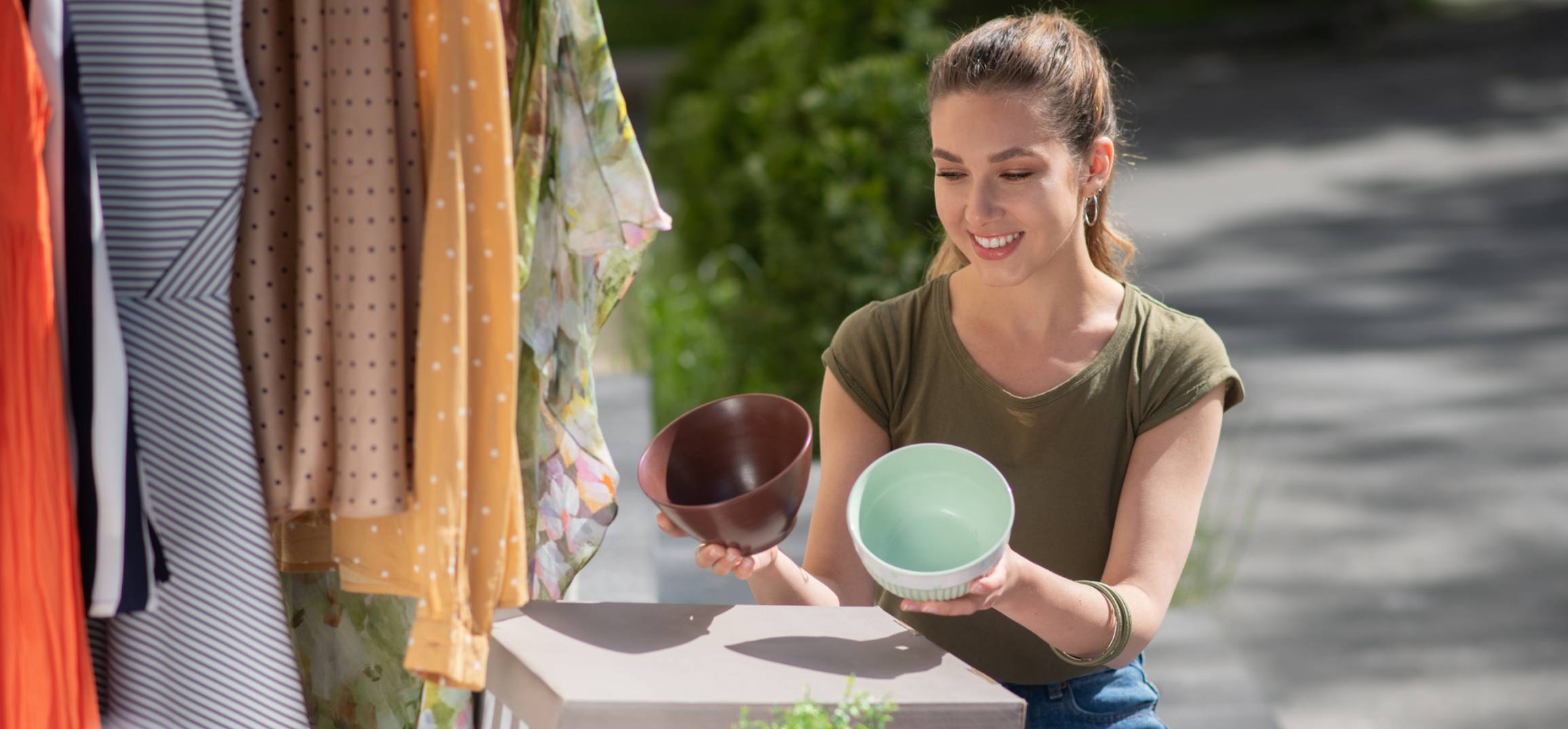Second Chances: A Guide to Getting Free (or Used) Stuff

By Sarah TreleavenOctober 4, 2022
Find out how to get quality pieces for almost nothing, all while keeping still-usable items out of the landfill.
Julie Rybarczyk has always been a fan of thrift shopping, and both her house and her wardrobe are full of second-hand finds from a combination of curated vintage boutiques and Craigslist postings. “I love to find things that have a story,” she says. “And obviously, you can get things at great, lower prices. But I also just love the hunt of it.” Some of her favourite finds include a pink couch that once belonged to Ann Landers, and a vintage café sign that now hangs in her dining room.
During the early stages of the pandemic, all locked down with nowhere to hunt, Rybarczyk discovered Facebook Marketplace, an online forum for buying and selling used goods—something that helped her stave off boredom. “I’m on Facebook Marketplace every day,” she says. “Every week I’m running around town to pick something up or I’m selling things or I’m ordering something that someone is going to ship to me. At this point, I sell things on Marketplace to support my Marketplace habit.”
And Rybarczyk’s not the only one. Neighbourhood buy & sell or “buy nothing” groups, typically online, aren’t a new phenomenon, but they are gaining newfound popularity as rising prices put a strain on household budgets. Some groups, like Facebook Marketplace, are driven by sophisticated algorithms based on your location; others, like the Instagram-based Stooping Toronto, have a smaller, neighbourhood vibe.
Some are drawn to these groups for environmental reasons, hoping to reduce their personal footprints by recycling and reusing items within their communities. These groups also gained additional steam during the pandemic, when health restrictions had many of us sitting at home, staring at the stuff we had been meaning to get rid of. Plus, with so many of life’s casual interactions — the people you see on the bus, the guy who makes you a latte — on hold, people reveled in the connections they were able to make in these online forums, even if they were just quickly swapping 10 wooden hangers for a mature jade plant during a meetup in a public park.
'I do love the community aspect of it,' says Rybarczyk. 'It's a fun way to have these little enjoyable interactions with people that are built on good will and sharing stories.'
Liesl Clark and Rebecca Rockefeller were thinking about community when they launched the “Buy Nothing Project” in Washington state in 2013. Clark was particularly motivated to start the Buy Nothing Project when she noticed how much trash was washing up on her beach — so much plastic junk that nobody needed anymore. As a filmmaker, Clark had spent a lot of time in Nepal, and she had become acquainted with the idea of communities pooling their resources to make sure that no one goes without, and nothing goes to waste. “They were basically cash-free cultures that take care of each other,” she says.
For Rockefeller, the cash-free part was especially important. When the Buy Nothing Project was conceived, she was an unemployed single mother of two kids who was barely scraping by. She suddenly found herself using the food bank that she had always donated to. Using the Buy Nothing group in her community was extremely empowering—not just because she could ask for what she need but because it gave her a chance to give back. “I wanted to be a giver, not just a taker,” she says. “I wanted an economy that we all participate in.”
Described as a “gift economy platform,” the Buy Nothing Project allows users to either offer something they no longer need or ask for something they do, the movement has since spread to 6.5 million community members in cities and towns around the world—a threefold increase since the start of the pandemic. Clark and Rockefeller also developed an app, which has been downloaded over 450,000 times.
One of the most impressive feats is the anything-and-everything nature of the exchanges. “It’s everything from clothing to auto parts, from kids’ toys to kitchen stuff and books,” says Clark. She lives on an island, so people often post ferry tickets that are on the verge of expiration. Gifts of service — offering to help someone move, lend a car or take someone foraging, for example — are particularly special. “That’s something people really treasure,” she says.
If you’re looking to find some treasures (or get rid of some of yours), here are some tips for making the most of these online communities:
- Start small: Rockefeller suggests dipping your toe into the online exchange with something relatively low stakes, such as a gift you know you’ll never use.
- Be clear about the condition of objects: These online groups tend to permit anything and everything, Clark says it’s important to be forthcoming about damage. “Everyone participates at their own risk, but you want people to be happy,” she says.
- Shop back to school: Online buy and sell groups are great for items that you only need temporarily, including stuff that could outfit a dorm room. Once the school year is up, students can throw those same items back on the site to clear up clutter and make a little extra cash.
- Get creative with your searches: If you’re searching for a very specific item or name brand, Rybarczyk suggests searching for both the correct name and common misspellings.
- Safety first: Rybarczyk says if you live alone, consider using “we” in correspondence. “I say, ‘we’ll be home at this time’ or ‘we’ll come to pick it up,'” she says. Many people also opt to make trades in a public place, like a park or coffee shop. When it comes to payment, a couple of things to keep in mind: check out buyer/seller profiles for any red flags (such as multiple profiles or very few connections), inspect goods before making payment and consider using a payment method recommended by the website you’re using to transact or one that offers some type of purchase protection.
- One person’s trash is truly another’s treasure: There’s a tendency to self-edit, but Clark cautions not to presume. She once off-loaded cement blocks to a neighbour building a chicken coop; they were the exact size she needed.
Things our lawyers want you to know
This article is intended as general information only and is not to be relied upon as constituting legal, financial or other professional advice. A professional advisor should be consulted regarding your specific situation. Information presented is believed to be factual and up-to-date but we do not guarantee its accuracy and it should not be regarded as a complete analysis of the subjects discussed. All expressions of opinion reflect the judgment of the authors as of the date of publication and are subject to change. No endorsement of any third parties or their advice, opinions, information, products or services is expressly given or implied by Royal Bank of Canada or any of its affiliates.




